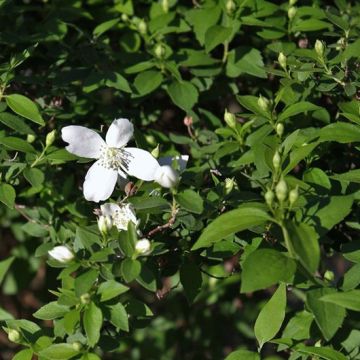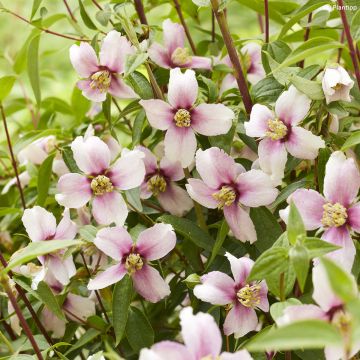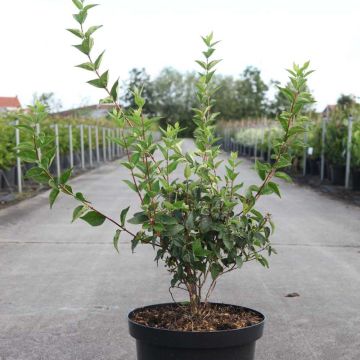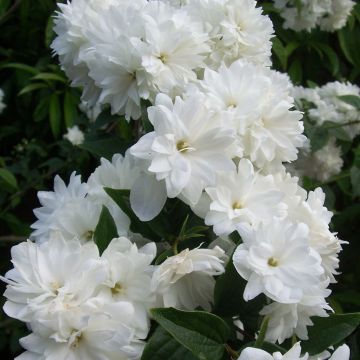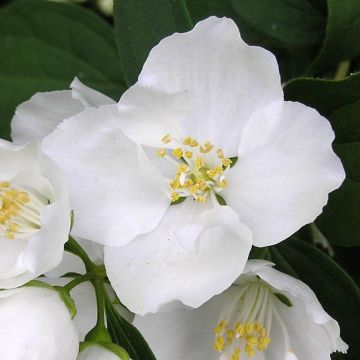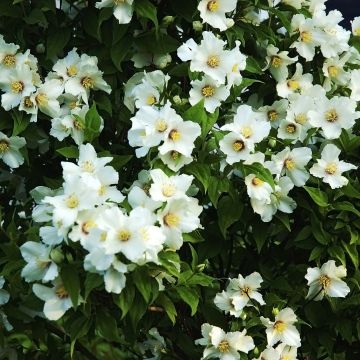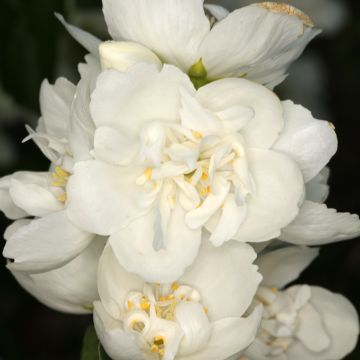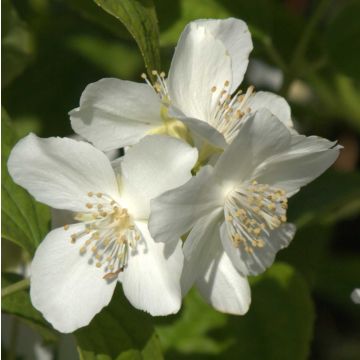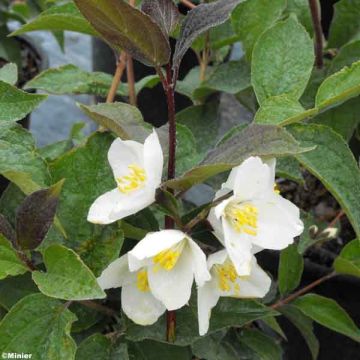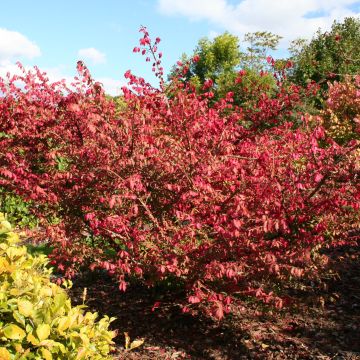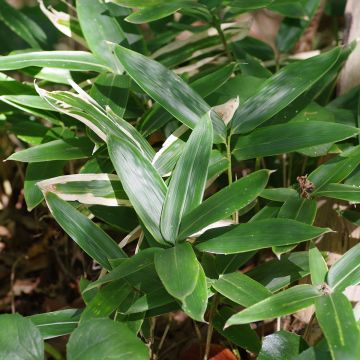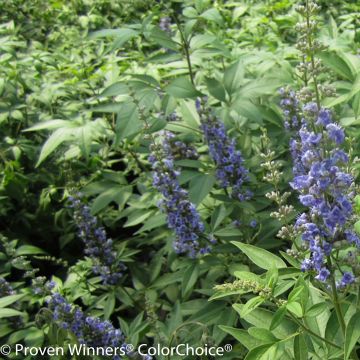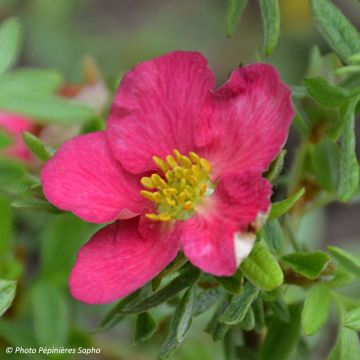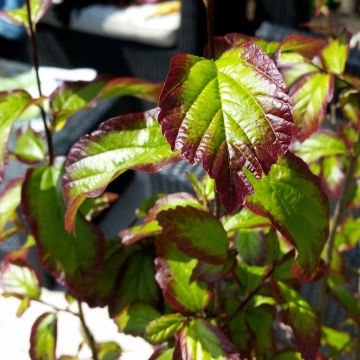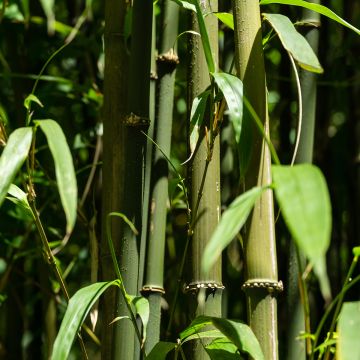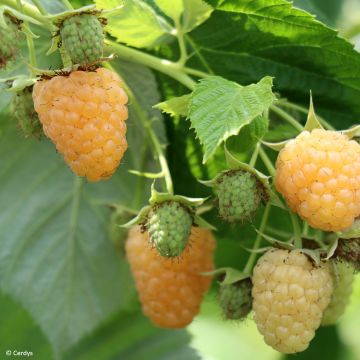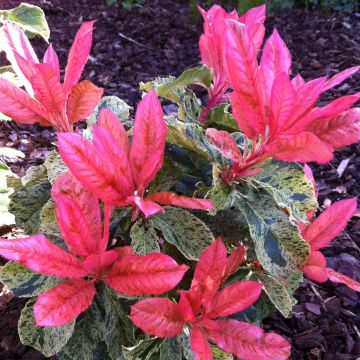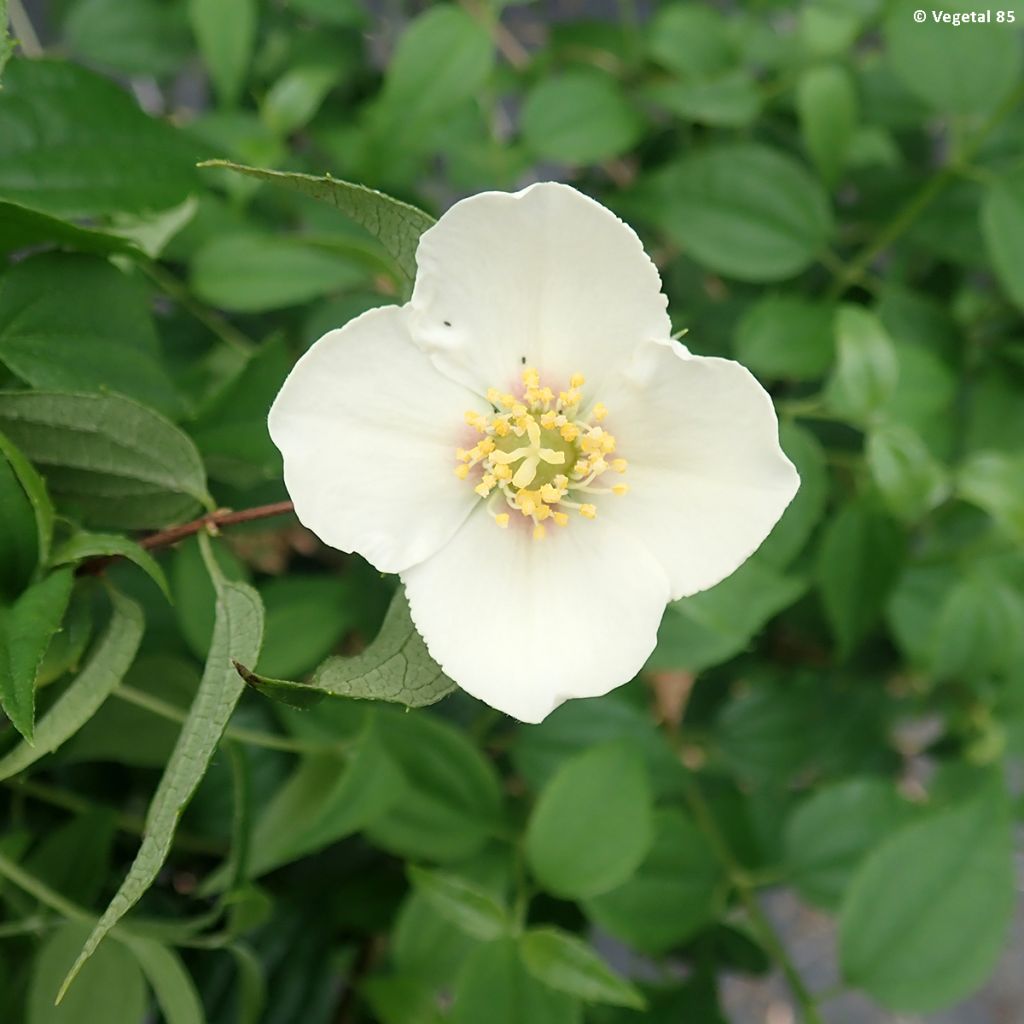

Seringat du Mexique - Philadelphus mexicanus
Philadelphus mexicanus - Mock Orange
Philadelphus mexicanus
Mock Orange
This item cannot be shipped to the selected country
Delivery charge from €5.90
More information
Schedule delivery date,
and select date in basket
This plant carries a 24 months recovery warranty
More information
We guarantee the quality of our plants for a full growing cycle, and will replace at our expense any plant that fails to recover under normal climatic and planting conditions.
From €5.90 for pickup delivery and €6.90 for home delivery
Express home delivery from €8.90.

Does this plant fit my garden?
Set up your Plantfit profile →
Description
The Philadelphus mexicanus, also known as the Mexican Mock Orange, is a botanical species distinguished by its distinctly trailing habit and single tea-like flowers, which are relatively large for a mock orange and have a sweet rose fragrance. They bloom in the axils of the leaves in late spring or summer. This remarkable bush, whose foliage remains evergreen in winter, is not the hardiest of all mock oranges. However, it is vigorous, water-efficient, and tolerates shade and limestone well. This mock orange is ideal for dressing up a slope or raised bed, as it naturally follows the contour. It also excels at climbing in a beautiful scented and flowering hedge. Planted in the right spot and once well-established, it requires no maintenance.
The Philadelphus mexicanus is native to central and southern Mexico and Guatemala and belongs to the Hydrangeaceae family. It is a long-lived plant that tolerates root competition from other shrubs. Its hardiness is estimated at -10 °C in well-drained soil that does not retain too much water in winter. It is a shrub with branches that stand up to 1m (3ft) in height and bend towards the ground, sometimes crawling. In nature, they weave and lean on the branches of other shrubs and trees. In the garden, they can be trained against supports. When planted in isolation, this mock orange naturally takes on a spreading and weeping habit, like a fountain. When trained, it grows rapidly and measures about 3m (10ft) in height, reaching a spread of 2.50m (8ft) in the long run. The trailing branches bear ovate leaves of medium green colour, sometimes partially serrated, reaching 11cm (4in) in length. Although theoretically evergreen in winter, they can become deciduous in severe frosts. Flowering occurs from June to July and may occur again in September. The flowers are single, with 4 petals, cup-shaped, creamy white in colour, and measure up to 4cm (2in) in diameter. Their fragrance, light to pronounced depending on the time and temperature, is a blend of rose and tuberose. This nectar-rich flowering attracts numerous pollinating insects.
The Mexican Jasmine is better suited to regions with mild winters. Apart from its relative lack of hardiness, it thrives almost anywhere, even in light shade, and tolerates the competition from other shrubs and tall trees. It is an excellent find for enthusiasts of rare plants. This shrub survives in dry soil during summer but prefers soil that retains some moisture. However, it will not survive winter in frozen clay. It finds its place in a countryside hedge alongside the Cornus mas, which flowers from February, the lilac (Syringa vulgaris), the Exochorda (E. serratifolia or korolkowii in limestone soil), or botanical roses. As it becomes less prominent after flowering, it is preferable to choose companion plants with staggered flowering or decorative foliage, deciduous or evergreen (Itea illicifolia, Garrya elliptica James Roof, Elaeagnus ebbingei).
Report an error about the product description
Philadelphus mexicanus - Mock Orange in pictures
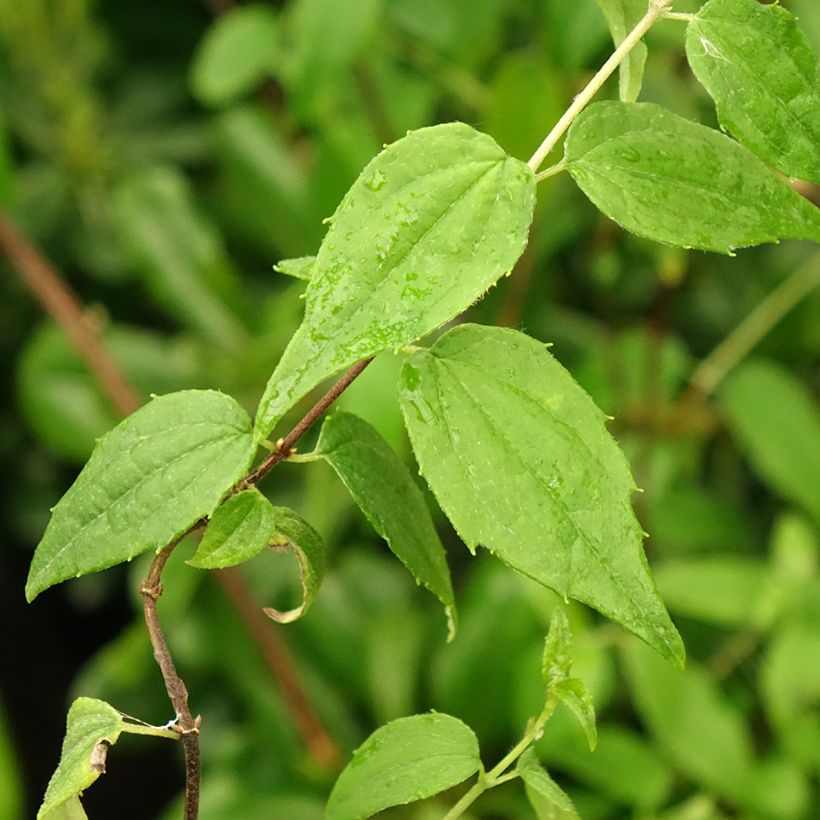

Plant habit
Flowering
Foliage
Botanical data
Philadelphus
mexicanus
Hydrangeaceae
Mock Orange
South America
Other Philadelphus - Mock Orange
Planting and care
The planting of Mexican Philadelphus is preferably done in spring in areas with limited hardiness and early autumn in frost-free areas. It is best to plant it in full sun to promote abundant flowering in cooler climates or in partial shade in warm regions to help it withstand water scarcity. This bush is not demanding in terms of soil, which can be slightly acidic, neutral, or even slightly alkaline, but requires well-drained soil. Clay soil that is waterlogged and frozen in winter will cause it to perish or significantly reduce its hardiness. Although some sources claim this mock orange is hardier, its hardiness is estimated at -10°C (14°F). Once rooted, it does not require watering in summer in all our regions.
The bush blooms on last year's branches so pruning should be done just after flowering. Severe pruning can be done every 2 to 3 years to keep it compact and highly floriferous. Do not hesitate to cut back the old wood and excessively long branches to the base of the plant to encourage it to branch out from the base. Although this bush is resistant, it can still be susceptible to powdery mildew and black aphids.
Planting period
Intended location
Care
This item has not been reviewed yet - be the first to leave a review about it.
Hedge shrubs
Haven't found what you were looking for?
Hardiness is the lowest winter temperature a plant can endure without suffering serious damage or even dying. However, hardiness is affected by location (a sheltered area, such as a patio), protection (winter cover) and soil type (hardiness is improved by well-drained soil).

Photo Sharing Terms & Conditions
In order to encourage gardeners to interact and share their experiences, Promesse de fleurs offers various media enabling content to be uploaded onto its Site - in particular via the ‘Photo sharing’ module.
The User agrees to refrain from:
- Posting any content that is illegal, prejudicial, insulting, racist, inciteful to hatred, revisionist, contrary to public decency, that infringes on privacy or on the privacy rights of third parties, in particular the publicity rights of persons and goods, intellectual property rights, or the right to privacy.
- Submitting content on behalf of a third party;
- Impersonate the identity of a third party and/or publish any personal information about a third party;
In general, the User undertakes to refrain from any unethical behaviour.
All Content (in particular text, comments, files, images, photos, videos, creative works, etc.), which may be subject to property or intellectual property rights, image or other private rights, shall remain the property of the User, subject to the limited rights granted by the terms of the licence granted by Promesse de fleurs as stated below. Users are at liberty to publish or not to publish such Content on the Site, notably via the ‘Photo Sharing’ facility, and accept that this Content shall be made public and freely accessible, notably on the Internet.
Users further acknowledge, undertake to have ,and guarantee that they hold all necessary rights and permissions to publish such material on the Site, in particular with regard to the legislation in force pertaining to any privacy, property, intellectual property, image, or contractual rights, or rights of any other nature. By publishing such Content on the Site, Users acknowledge accepting full liability as publishers of the Content within the meaning of the law, and grant Promesse de fleurs, free of charge, an inclusive, worldwide licence for the said Content for the entire duration of its publication, including all reproduction, representation, up/downloading, displaying, performing, transmission, and storage rights.
Users also grant permission for their name to be linked to the Content and accept that this link may not always be made available.
By engaging in posting material, Users consent to their Content becoming automatically accessible on the Internet, in particular on other sites and/or blogs and/or web pages of the Promesse de fleurs site, including in particular social pages and the Promesse de fleurs catalogue.
Users may secure the removal of entrusted content free of charge by issuing a simple request via our contact form.
The flowering period indicated on our website applies to countries and regions located in USDA zone 8 (France, the United Kingdom, Ireland, the Netherlands, etc.)
It will vary according to where you live:
- In zones 9 to 10 (Italy, Spain, Greece, etc.), flowering will occur about 2 to 4 weeks earlier.
- In zones 6 to 7 (Germany, Poland, Slovenia, and lower mountainous regions), flowering will be delayed by 2 to 3 weeks.
- In zone 5 (Central Europe, Scandinavia), blooming will be delayed by 3 to 5 weeks.
In temperate climates, pruning of spring-flowering shrubs (forsythia, spireas, etc.) should be done just after flowering.
Pruning of summer-flowering shrubs (Indian Lilac, Perovskia, etc.) can be done in winter or spring.
In cold regions as well as with frost-sensitive plants, avoid pruning too early when severe frosts may still occur.
The planting period indicated on our website applies to countries and regions located in USDA zone 8 (France, United Kingdom, Ireland, Netherlands).
It will vary according to where you live:
- In Mediterranean zones (Marseille, Madrid, Milan, etc.), autumn and winter are the best planting periods.
- In continental zones (Strasbourg, Munich, Vienna, etc.), delay planting by 2 to 3 weeks in spring and bring it forward by 2 to 4 weeks in autumn.
- In mountainous regions (the Alps, Pyrenees, Carpathians, etc.), it is best to plant in late spring (May-June) or late summer (August-September).
The harvesting period indicated on our website applies to countries and regions in USDA zone 8 (France, England, Ireland, the Netherlands).
In colder areas (Scandinavia, Poland, Austria...) fruit and vegetable harvests are likely to be delayed by 3-4 weeks.
In warmer areas (Italy, Spain, Greece, etc.), harvesting will probably take place earlier, depending on weather conditions.
The sowing periods indicated on our website apply to countries and regions within USDA Zone 8 (France, UK, Ireland, Netherlands).
In colder areas (Scandinavia, Poland, Austria...), delay any outdoor sowing by 3-4 weeks, or sow under glass.
In warmer climes (Italy, Spain, Greece, etc.), bring outdoor sowing forward by a few weeks.


































